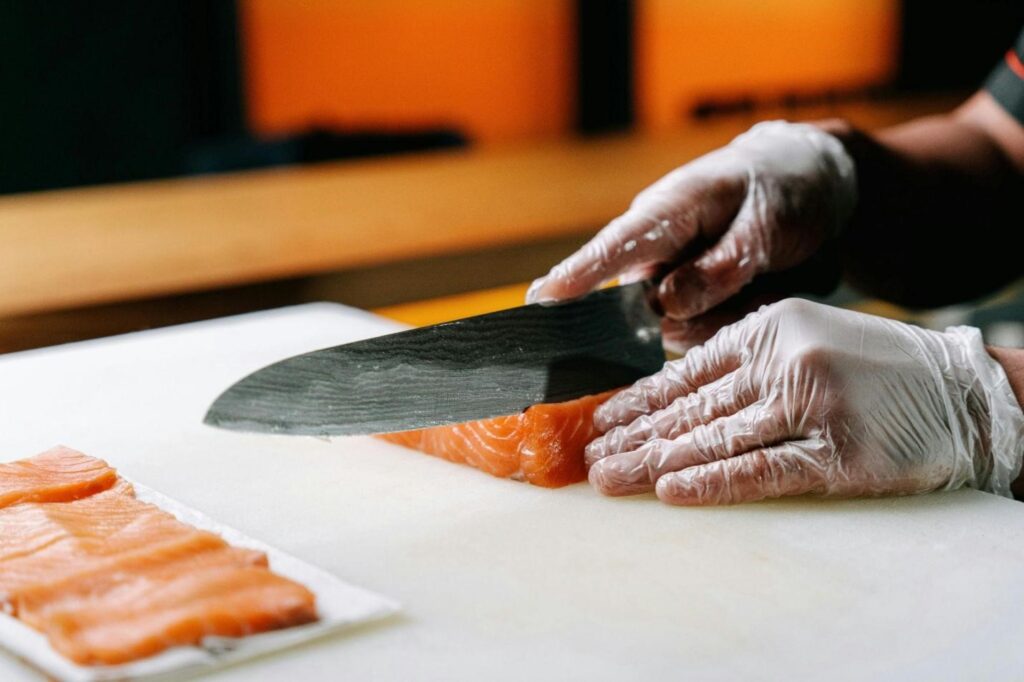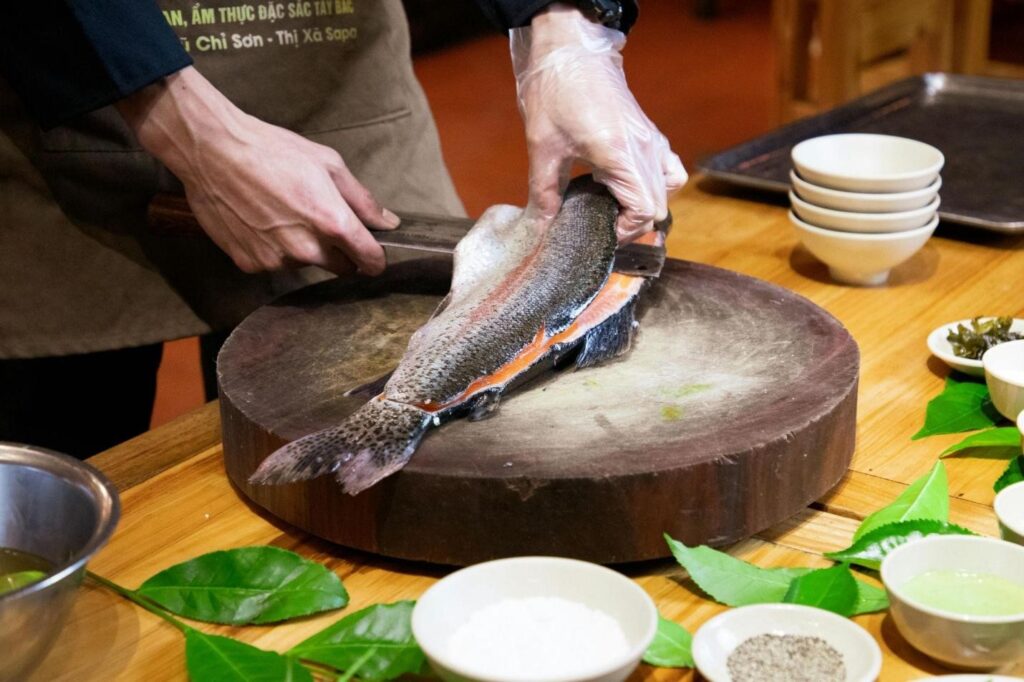Preparing delicate proteins like fish, eggs, and tender meats requires finesse and the right knife techniques.
Using the proper methods allows you to slice cleanly without mangling the ingredients. And with some practice, you can become proficient at handling delicate proteins.
Why Knife Skills Matter for Delicate Foods
Delicate proteins have soft, tender textures that are easily damaged by rough knife work. If you hack haphazardly at a fillet of fish or don’t cut eggs cleanly, you end up with messy, unappealing pieces.
Proper knife skills lead to uniform sizes and shapes, neat cuts, and ingredients that hold together better during cooking. The right techniques also enable you to work efficiently and safely. Handling a sharp knife improperly risks injury, so adopting good habits is crucial.
Choosing the Right Knives
You’ll need knives with thin, sharp blades that can make precise, clean slices. The best options include:
Chef’s knife – An all-purpose knife ideal for most tasks like slicing fish fillets, butterflying meats, or mincing shallots. A 6 to 8-inch blade works well.
Boning knife – The thin, sharp blade excels at removing bones and skinning fish. It also handles detailed cuts on chicken, meat, and fish.
Paring knife – Perfect for delicate tasks like deveining shrimp, peeling garlic, or intricate vegetable cuts.
Serrated knife – The slight teeth on the blade let you neatly slice tender proteins like smoked salmon without tearing.
Slicer knife – Designed to carve thin, even slices of proteins like roast turkey or beef tenderloin.
High-carbon stainless steel offers durability and strength while resisting stains. Honing steels realign and straighten knife edges between full sharpenings. Well-maintained knives perform best.
Proper Knife Handling Basics
No matter what knife you use, always follow basic safety:
- Secure ingredients by anchoring them to a board with your knuckle or a claw grip. This protects your non-knife hand.
- Keep the blade pointed away from your body.
- Use a handle grip for control and leverage when cutting.
- Slice ingredients deliberately with smooth motions using the knife’s center area. Avoid a sawing action.
- Always cut on a sturdy surface at a comfortable height.
Prepping Fish and Seafood
Seafood prep relies on careful knife work to avoid shredding the delicate flesh. Follow these tips:
- Remove skin – Use a boning knife to slice under the skin starting at the tail. Glide the blade along the skin at a shallow angle to separate it without cutting into the flesh.
- Portion fillets – Place skin-side down and make vertical cuts with a chef’s or slicer knife, using the central bone line as a guide. Rinse the knife often to prevent sticking.
- Butterfly – For even cooking, lay fillets skin-side up. Slice horizontally from head to tail end, leaving about 1 inch attached. Open up like a book.
- Devein shrimp – Use the tip of a paring knife to make a shallow cut along the shrimp’s back to expose the digestive tract. Remove and discard the vein with a knife tip.
- Shuck oysters – Protect your hand with a glove or towel. Work the oyster knife tip into the hinge to pop the shell open. Scrape the knife along the top shell to sever the muscle.
Handling Eggs and Egg Dishes
Preparing egg-based dishes starts with properly cutting and slicing:
- Hard boil eggs – Use a chef’s knife to gently tap the wider side of the egg to crackle the shell. This makes peeling easier. Undercook slightly for firm but tender eggs.
- Poach eggs – For perfectly oval poached eggs, crack them into a small bowl first, then gently slide them into simmering water. Aim for roughly the same size.
- Slice hard-boiled eggs – Anchor peeled egg on a board and use a chef’s or serrated knife to carefully trim off ends. Make even slices from base to tip.
- Chopped eggs – For egg salad or garnishes, finely chopped hard-boiled eggs with a chef’s knife using a rocking motion. Don’t mash eggs.
- Frittatas and quiche – Saute vegetables first. Then stir egg mixtures gently when adding to the pan. Use a heatproof rubber spatula to avoid tearing.
Prepping Meat and Poultry
Precision knife skills help you prepare beef, poultry, and pork without damaging the tender proteins:
- Butterfly chops and cutlets – Place meat presentation-side down. Use a sharp chef’s knife to slice almost in half horizontally. Open up gently like a book.
- Trim meats – Use a sharp boning knife to carefully slice away excess fat and connective tissue. Cut against the grain of the meat.
- French a rack of lamb – Have the butcher french the rack by exposing the bones for presentation. Scrape bones clean with a paring knife.
- Carve roasts – Let roasts like prime rib and turkey rest before carving with a slicing knife. Cut thin slices across the grain for tenderness.
- Bone chicken – Use a boning knife to carefully detach meat, leaving it intact. Scrape bones with a knife tip to remove clinging meat and tendons.
Maintaining Proper Cutting Motion
The way you handle and move your knife directly impacts the quality of your cuts. To prep delicate proteins cleanly:
- Grip the knife securely but without tenseness. Let wrist and arm remain loose to allow fluid motion.
- Use your knuckles as a guard, keeping your fingers curled under. Keep thumbs tucked in too.
- Slice ingredients with controlled, even pressure along the knife blade.
- Use smooth, continuous motions without stopping halfway through a cut. Follow through.
- Let the knife do the work rather than forcing it through ingredients crudely.
Patience and practice are vital for handling delicate proteins. Focus on precision over speed for the cleanest cuts. Master fundamental knife skills, and intricate dishes will be approachable.
Tips for Slicing Delicate Proteins Perfectly
You can prep elegant dishes when you know how to slice delicate ingredients like smoked salmon, prosciutto, and steak cleanly:
Smoked salmon – For pretty appetizers, use an ultra-sharp slicer or serrated knife to cut paper-thin slices at an angle with the grain.
Prosciutto – Chill meat first so it’s slightly firm for easier slicing. Use a sharp deli slicer, carving knife, or chef’s knife to cut thin slices.
Beef carpaccio – Trim beef tenderloin well first and scrape away sinew. Freeze meat briefly to firm it up before thinly slicing it against the grain.
Foie gras – Chill liver before slicing thinly with a serrated knife. Cut on a slight diagonal following the natural seam lines in the liver.
Sashimi – For the prettiest cuts, slice fish while still partially frozen using a long slicing knife. Cut on a slight angle.
Key Knife Cuts to Master
Once you know how to handle a knife properly, these basic cuts expand your prep possibilities:
Dice – Cut food into small, even cubes. First cut vertically into strips, then horizontally into cubes. Keep pieces uniform.
Chop – Slice ingredients randomly into smaller pieces, not necessarily uniform in size or shape. Use a rocking motion.
Mince – Finely and evenly chop foods like garlic, shallots, and herbs into tiny bits without bruising. A razor-sharp knife helps.
Julienne – Slice into thin matchstick strips by first cutting into a long rectangle. Then stack strips and cut lengthwise.
As you become more adept with your knives, you can attempt fancy cuts like chiffonade, paysanne, brunoise, and tourne. But master the basics first. Soon you’ll be prepping intricate dishes!


